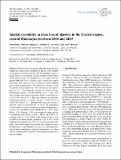Files in this item
Spatial variability in mass loss of glaciers in the everest region, central Himalayas, between 2000 and 2015
Item metadata
| dc.contributor.author | King, Owen | |
| dc.contributor.author | Quincey, Duncan J. | |
| dc.contributor.author | Carrivick, Jonathan L. | |
| dc.contributor.author | Rowan, Ann V. | |
| dc.date.accessioned | 2019-11-27T10:30:06Z | |
| dc.date.available | 2019-11-27T10:30:06Z | |
| dc.date.issued | 2017-02-03 | |
| dc.identifier | 263617085 | |
| dc.identifier | c9402495-ae71-436e-8ce7-ee51894a3c88 | |
| dc.identifier | 85011634481 | |
| dc.identifier.citation | King , O , Quincey , D J , Carrivick , J L & Rowan , A V 2017 , ' Spatial variability in mass loss of glaciers in the everest region, central Himalayas, between 2000 and 2015 ' , Cryosphere , vol. 11 , pp. 407-426 . https://doi.org/10.5194/tc-11-407-2017 | en |
| dc.identifier.issn | 1994-0416 | |
| dc.identifier.uri | https://hdl.handle.net/10023/19009 | |
| dc.description | Owen King is a recipient of a NERC DTP PhD studentship. | en |
| dc.description.abstract | Region-wide averaging of Himalayan glacier mass change has masked any catchment or glacier-scale variability in glacier recession; thus the role of a number of glaciological processes in glacier wastage remains poorly understood. In this study, we quantify mass loss rates over the period 2000-2015 for 32 glaciers across the Everest region and assess how future ice loss is likely to differ depending on glacier hypsometry. The mean mass balance of all 32 glaciers in our sample was -0.52±0.22m water equivalent (w.e.)a-1. The mean mass balance of nine lacustrine-terminating glaciers (-0.70±0.26mw.e.a-1) was 32% more negative than land-terminating, debris-covered glaciers (-0.53±0.21mw.e.a-1). The mass balance of lacustrine-terminating glaciers is highly variable (-0.45±0.13 to -0.91±0.22mw.e.a-1), perhaps reflecting glacial lakes at different stages of development. To assess the importance of hypsometry on glacier response to future temperature increases, we calculated current (Dudh Koshi - 0.41, Tama Koshi - 0.43, Pumqu - 0.37) and prospective future glacier accumulation area Ratios (AARs). IPCC AR5 RCP 4.5 warming (0.9-2.3°C by 2100) could reduce AARs to 0.29 or 0.08 in the Tama Koshi catchment, 0.27 or 0.17 in the Dudh Koshi catchment and 0.29 or 0.18 in the Pumqu catchment. Our results suggest that glacial lake expansion across the Himalayas could expedite ice mass loss and the prediction of future contributions of glacial meltwater to river flow will be complicated by spatially variable glacier responses to climate change. | |
| dc.format.extent | 20 | |
| dc.format.extent | 9130322 | |
| dc.language.iso | eng | |
| dc.relation.ispartof | Cryosphere | en |
| dc.subject | G Geography (General) | en |
| dc.subject | Earth-Surface Processes | en |
| dc.subject | Water Science and Technology | en |
| dc.subject | DAS | en |
| dc.subject | SDG 13 - Climate Action | en |
| dc.subject.lcc | G1 | en |
| dc.title | Spatial variability in mass loss of glaciers in the everest region, central Himalayas, between 2000 and 2015 | en |
| dc.type | Journal article | en |
| dc.contributor.institution | University of St Andrews. School of Geography & Sustainable Development | en |
| dc.identifier.doi | 10.5194/tc-11-407-2017 | |
| dc.description.status | Peer reviewed | en |
This item appears in the following Collection(s)
Items in the St Andrews Research Repository are protected by copyright, with all rights reserved, unless otherwise indicated.

